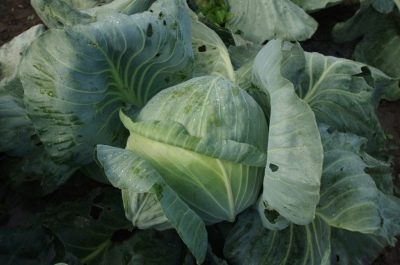
- Authors: Monachos G.F.
- Year of approval: 2011
- Appointment: for fresh consumption
- Leaf rosette: raised
- Leaf size: large
- Leaf color: blue-green
- Sheet surface: slightly bubbly
- Outside stump: long
- Internal stump: middle length
- Weight, kg: 1,9-3,4
The dominant is a hybrid variety of white cabbage, which was bred by Russian breeders. The variety was approved for use in 2011 and over the years it has acquired a whole army of fans in the circles of gardeners.
Description of the variety
The Dominant variety is grown in the open field, the fruits are distinguished by high marketability - 89%, excellent taste and long shelf life. Heads of cabbage keep keeping quality for six months. In addition, this hybrid has versatility and good portability. It is recommended to grow it in the North-West, Central, Volgo-Vyatka, Nizhnevolzhsky, Far East regions and the Central Black Earth Region.
Characteristics of the appearance of the plant and heads of cabbage
The Dominant is characterized by the following external features:
raised socket;
large blue-green leaves with bubbles on the surface and a wave along the edge;
long inner and outer stumps;
forks weighing 1.9-3.4 kg, rounded, blue-green outside and whitish inside.
Purpose and taste
The head of cabbage is quite dense, this indicator is estimated at 4.5 points. Consumers note the very good taste of the fruit. The taste is revealed especially brightly in the fresh vitamin salad. And also this cabbage is suitable for adding to soup, for stewing or for use as a filling for pies and pancakes.
Ripening terms
The heads of cabbage can be removed at the stage of technical maturity only 160-170 days after the appearance of the first shoots, which is typical for varieties with a late ripening period. Harvesting is usually done between September and October.
Yield
The Dominant variety has a high yield. From one hectare, you can get an average of 339-600 centners of cabbage.
Growing and caring
It is best to sow this variety in March, then the transplant to the summer cottage will be carried out in May. Before sowing, the planting material must be etched in a solution of potassium permanganate. The soil for seedlings must be treated with the same solution, and then calcined in the oven. The dominant prefers to develop in fertile soil. Plant the seeds to a depth of 0.5-1 cm. When the seedlings hatch, place the container in a lighted place in a room where the temperature is kept at + 15 ... 17 degrees. Thinning will be required in the cotyledonous leaf phase.
When the time for transplanting comes, the bushes are planted according to the scheme 60x60 cm.The first four weeks the plants are watered often and little by little. The more mature the bushes become, the less often moisture should be, but the volume of water should increase. For this variety, it will be useful to organize drip irrigation.
Top dressing will be needed three times per season. The first time the plant is fertilized 10 days after transplantation, during this period organic or mineral nitrogen-containing compounds are suitable. After the forks are formed, it is recommended to feed the vegetable with nitrophos or potassium monophosphate.
And also when caring for a plant, it is important to loosen the soil, this should be done the next day after watering. Weeds should be removed at the same time.

To grow a rich cabbage crop, you need to know when and how to plant this crop outdoors. Planting dates are determined depending on the variety. It is also necessary to properly prepare the soil and follow the rules of crop rotation.



Cabbage requires particularly careful care when growing. The plant quickly absorbs nutrients, so the soil needs to be enriched regularly. Adequate amounts of minerals, organics and nitrogen must be provided. Some products can be purchased at the store, while others are easy to make at home.
Disease and pest resistance
This variety does not undergo cracking and is almost not affected by fusarium wilt, but can be infected with other diseases or become a victim of insects. For example, a plant can get sick with a keel or a fungal disease. To avoid this, observe the following preventive measures.
Observe the crop rotation. Plant vegetables away from other cruciferous crops. Change the planting bed every year.
Do not overdo it with watering, it should be moderate.
Treat seeds and soil with fungicides before planting.
For the prevention of keels, use a solution of colloidal sulfur. The preparations "Oxyhom" or "Abiga-Peak" will help against fungi.
To prevent the invasion of insects, it is recommended to use the means "Fufanon", "Knockdown", "Bazudin", "Iskra-M". From folk remedies, wood ash has proven its effectiveness, with which it is customary to sprinkle the soil and the plants themselves.

Cabbage is a very popular horticultural crop. But growing a good, large and tasty cabbage is sometimes very difficult, because it is often affected by a huge number of diseases and pests. The main role in the cultivation of this vegetable is played by regular prevention, which helps to get a rich harvest, and prevent the occurrence of diseases and the invasion of harmful insects. It is very important to start treatment as early as possible, otherwise there is a risk of spreading the infection to unaffected plants.























































































